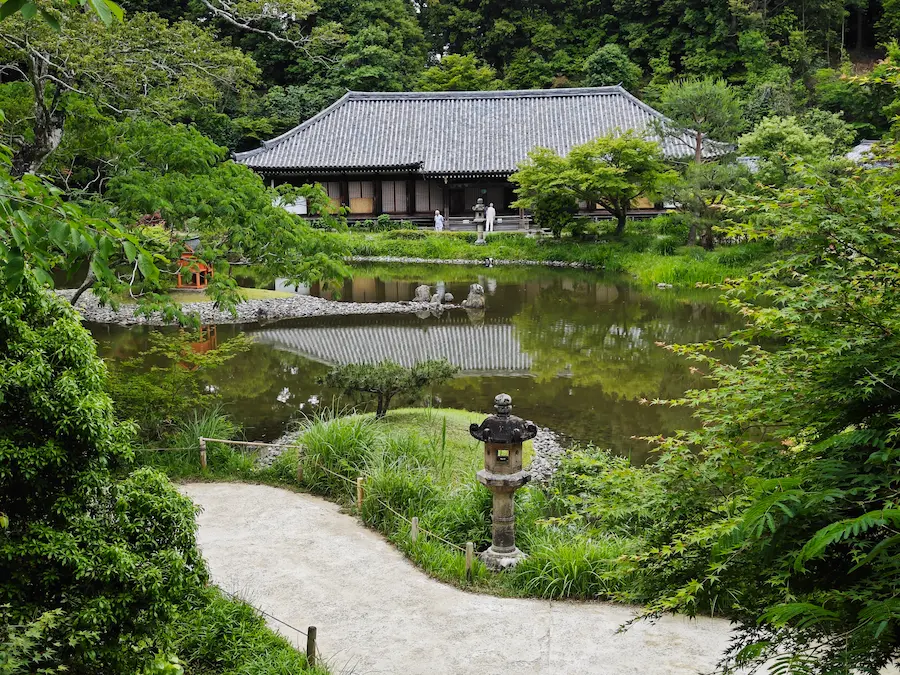Joruriji Temple, also known as Joruri Temple, is a historic and culturally significant temple located in the Kizugawa City of Kyoto Prefecture, Japan. It is not in the Kyoto City, and it takes about 2 hours by public transport.
Joruriji Temple is famous for its beautiful gardens, ancient structures, and the rich cultural heritage it embodies. The temple belongs to the Shingon sect of Japanese Buddhism and the main deity is Amida Nyorai (Amitabha Buddha).

Historical Background of Joruriji
Joruriji Temple was founded in the Heian period, around the year 1047. The temple’s founder was a monk Eshin Sozu (Genshin), who was a prominent figure in the development of Pure Land Buddhism in Japan. The Heian period was a time when Buddhism flourished in Japan. And nobles built many temples as centers of religious practice and cultural activities.
The temple’s name, “Joruri,” means the Pure Land of Amitabha Buddha, reflecting its religious significance. Over the centuries, Joruriji Temple has undergone several renovations and restorations to preserve its structures and cultural assets. Many of which are now designated as Important Cultural Properties by the Japanese government.
Architectural Highlights
Joruriji is particularly famous for its architectural design, which includes a blend of Heian and Kamakura period styles. The main hall, known as the Kondo, houses a set of nine Amida Nyorai statues.

These are a rare and significant example of Heian period Buddhist sculpture. Today, Joruriji Temple is the only temple where nine Amitabha Buddha statues remain. These statues line in three rows of three, symbolizing the Pure Land of Amitabha Buddha. And they are a key attraction for visitors and scholars alike.

You can see better photos here.
Another notable structure within the temple grounds is the pagoda. The three-story pagoda, a National Treasure, is an architectural marvel. The pagoda stands majestically within the temple complex, adding to the serene and picturesque environment. According to records, this three-story pagoda was once located in Heian-kyo, but was moved in 1178.
Cultural Significance
Joruriji is not only significant for its architectural beauty but also for its cultural heritage. The temple’s gardens are a fine example of the Heian period garden design, characterized by a pond surrounded by lush greenery and meticulously arranged plants and stones. This garden design represents the Buddhist concept of paradise and provides a peaceful retreat for contemplation and meditation.
The temple’s connection to the Pure Land Buddhism is further emphasized through its cultural artifacts. These include sutras, mandalas, and various religious implements used in Buddhist rituals. These artifacts provide valuable insights into the religious practices and beliefs of the Heian period.
Unveiling National Treasures of Joruriji
Beyond its architectural and natural beauty, Jōruri-ji houses a collection of invaluable cultural treasures. They further enrich its spiritual and historical significance. Among these treasures are:
- Nine Sitting Statues of Amida Buddha: These statues, designated as National Treasures, are considered masterpieces of Buddhist sculpture. Carved from wood and adorned with gold leaf, they embody the essence of Amida’s compassionate nature.
The nine Amitabha Nyorai statues represent the idea that there are nine stages of life. The largest statue of Amitabha Nyorai, in the center of the main hall, was the first of the nine statues to be made in the late 11th century. The other eight are from the early 12th century. The facial expressions of these statues and the motif of the halo behind their heads are different from each other. - Three-story Pagoda: This iconic structure, also a National Treasure, stands as a testament to the temple’s rich architectural heritage. Its graceful proportions and intricate details reflect the artistry of the Kamakura period (1185-1333).
- Garden: The garden itself, designated as a National Special Scenic Spot and Historic Site, is a living work of art. It embodies the principles of Japanese landscape design and reflecting the Pure Land paradise.
Preservation and Public Access
Efforts to preserve Joruriji’s historical and cultural assets have been ongoing for many years. The temple is open to the public. Visitors can explore its grounds, view the exquisite statues and structures, and experience the tranquility of its gardens. Special events and religious ceremonies attract both local worshippers and tourists from around the world.
In recent years, Joruriji has become a popular destination for those interested in Japanese history, architecture, and Buddhism. The temple’s serene environment, combined with its historical significance, offers a unique glimpse into Japan’s rich cultural heritage.
Joruriji stands as a testament to the enduring legacy of Japanese Buddhism. It also demonstrates the artistic achievements of the Heian and Kamakura periods. Its well-preserved structures, beautiful gardens, and significant cultural artifacts make it an invaluable part of Japan’s historical and cultural landscape. As a place of worship and a cultural treasure, Joruriji Temple continues to inspire and attract visitors. It offers a profound connection to Japan’s past and its spiritual traditions.
Tours to Joruriji Temple
Currently, there are no package tours available from Kyoto to visit Joruriji Temple. If you like to have a guide to visit Joruriji Temple, possibly with Gansenji Temple, please Contact us from here. It is a perfect one-day tour from Kyoto including one-hour hiking.
Related articles:
[…] tours to the Gansenji Temple is not available. If you like to visit Gansenji together with nearby Joruriji Temple, please Contact us from here. It is a perfect one-day tour from Kyoto including one-hour […]
[…] five-story pagoda in existence is the pagoda at Daigoji Temple. Also, the three-story pagoda of Joruriji Temple is a relocated version of one of the pagodas built in Kyoto around this […]